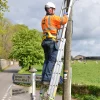Study Examines Patchy UK Mobile Coverage on the South West Mainline

Network analyst firm Streetwave has conducted an anecdotal study of UK mobile coverage (4G, 5G etc.) and mobile broadband speeds along the South West Mainline – as operated by South Western Railway (SWR). This found that customers connected via mobile operator EE received the best coverage, while O2 were the weakest.
The South West Mainline is a 143 miles long (230km) major railway (train) line between London’s central Waterloo station and Weymouth (Dorset) on the central south coast of England. The line is a key commuter route and around 118 trains a day run between the cities according to Trainline.
Streetwave defines “Essential Coverage” as being reflective of locations where the network provides users with connectivity of above 1Mbps download speeds, 0.5Mbps upload, and below 100ms (milliseconds) of latency (i.e. covering or allowing only the most basic of use cases / needs).
Advertisement
Overall, EE delivered the highest levels of Essential Coverage across the line – with 68% of the railway covered and their “simulated passenger” being without a dependable internet connection for a total of 44 minutes during the trip. But others fared worse. The fact that EE came top is not so surprising when you consider that SWR has a strategic partnership with BT (who manage the EE network, which SWR’s onboard Wi-Fi uses).
Essential Coverage Scores on South West Mainline
1. EE – 68%
2. Vodafone – 55%
3. Three UK – 42%
4. O2 – 33%Time Simulated Passenger Spent Without a Dependable Internet Connection
1. EE – 44 minutes
2. Vodafone – 61 minutes
3. Three UK – 79 minutes
4. O2 – 91 minutes
The survey was admittedly very anecdotal and really needed to be conducted several times, on different days and times of day, in order to produce a stronger level of data. But it does still provide a useful, if limited, snapshot of how mobile connectivity performs on the line (remember the onboard Wi-Fi service is usually also supplied via mobile capacity).
The results might also help to inform the current debate between mobile operators and the government. This is over whether public money should be diverted from the £1bn industry-led Shared Rural Network (SRN) to subsidise coverage improvements along Britain’s railway lines.
Finally, it’s worth noting that SWR are currently developing “superfast Wi-Fi technology” with FirstGroup, which will be installed between Earlsfield and Basingstoke. This trackside solution will be fully integrated with their existing onboard Wi-Fi service, which will benefit their mainline passengers.
Advertisement
Mark is a professional technology writer, IT consultant and computer engineer from Dorset (England), he also founded ISPreview in 1999 and enjoys analysing the latest telecoms and broadband developments. Find me on X (Twitter), Mastodon, Facebook, BlueSky, Threads.net and Linkedin.
« Fibrus Founder Criticises Openreach “Pole Tax” on UK Fibre Broadband Builds























































I’ve commuted on this line for years and I do not agree with the findings of this survey.
O2 and Vodafone are by far and away the best on this line, O2’s biggest problem is that it drops down to 3G too much but the connection still works for basic tasks, whereas in those same cases EE has no service.
EE is slightly better towards London although TERRIBLE around Clapham Junction, truly appalling.
How can you possibly know unless you habitually travel with three phones, all connected to different networks?
“Gigabit” won’t be happy.
EE is decent just not as good in my experience as O2 and Vodafone. They are terrible around Clapham Junction though for some reason. O2 and VF have a site there whereas EE don’t which has always puzzled me.
I accept I’m disagreeing with the study but my own anecdotal experience doesn’t match up that’s all. As I said I have done this route for years and years and years.
Mobile coverage is fairly terrible across large areas of the country. You’d think that holding networks’ claims to account and verifying the coverage data they publish would be Ofcom’s job, but apparently it falls to a private company doing it (presumably) as part of a marketing effort to realise that a network like O2 can only give you a usable mobile service for one third of a mainline rail commute.
If it was like this between 6:30-8:30 in the morning, I doubt it would be any better during the day.
Just stick starlink antennas multiple times along on the roof of these trains bridge it together and then connect it as the backhaul to the on-board wi-fi. Deploy Openroaming on the WiFi to provide everyone with a private, secure, and seamless roaming connection and limit everyone to 5Mbs download speeds.
The most cost effective solution which could be deployed really quickly and would provide everyone a decent and consistent quality of experience.
Ah yes, there’s always a solution to every engineering problem that begins with the word “Just”.
I use the Onboard WiFi and I have no problems
I can make and receive Calls around Clapham Junction
I am on EE
I don’t doubt you can make calls at CJ but during peak times I’ve found EE completely hopeless, frequently dropping to band 20. As you can see on Cellmapper EE are lacking a site there.
Obviously would have been even worse had they did the entire trip, and not finished it at Bournemouth…
A bit disgraceful in 2025. Has anyone tried comparing these percentages with say Swisscom coverage on some rural sections of SBB’s railway? The whole point in train travel is to be able to get some work done at the same time, otherwise we may as well drive.